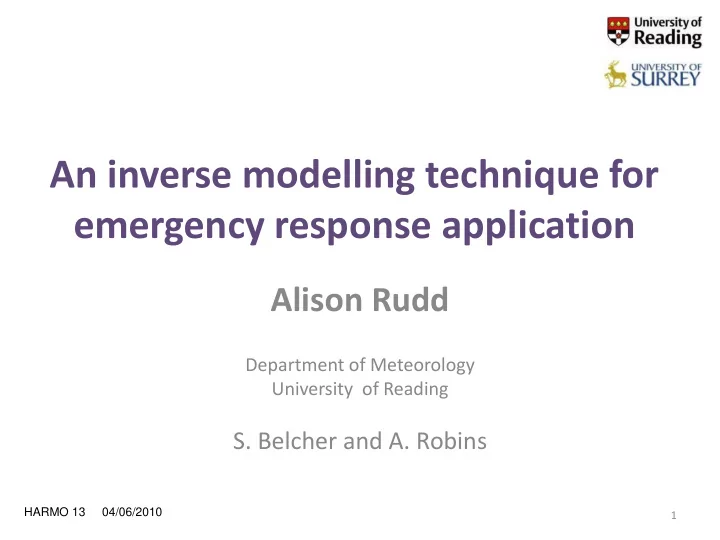

An inverse modelling technique for emergency response application Alison Rudd Department of Meteorology University of Reading S. Belcher and A. Robins HARMO 13 04/06/2010 1
Malicious or accidental release in an urban area What area should the first responders cordon off or evacuate? What are the source characteristics? - uncertainty Where will the plume spread? 2
Chemical sensor Source position Malicious or accidental release in an urban area What area should the first responders cordon off or evacuate? What are the source characteristics? - uncertainty Where will the plume spread? 3
The DYCE consortium DYnamic deployment planning for monitoring of ChEmical leaks using an ad-hoc sensor network Chemical sensors Communications & networking Inverse modelling to estimate the source characteristics Wind tunnel & tracer trial validation studies Funding
Inverse modelling Inverse problem: extracting source characteristics from a set of concentration measurements y x 1. Make a first guess of the source characteristics (Q, X s , Y s ) 2. First guess forward model model-predicted concentrations 3. Model-predicted concentrations vs. measured concentrations Minimisation algorithm `best’ estimate of source characteristics. 4. `Best’ estimate forward model predicted plume. 5
Forward model Forward model model-predicted concentrations Gaussian plume model - well known and understood Inputs: source strength and position, wind speed and stability We assume – one continuous point source – a ground level release, i.e. Z s = 0 – concentration measurements at ground level 2 ( Y Y ) Q s C exp 2 u 2 Y Z Y 6
Optimisation 2 o m C C 1 N i i Minimise a cost function J 2 2 i 1 i Concentration measurements C o Model-predicted concentrations C m Measures the discrepancy between the measured and model-predicted concentrations Minimise J, which is the same as finding the values of the source characteristics for which the gradient of J is zero. This is your `best’ estimate of the source characteristics. Least squares fit plus error weighting which leads to an uncertainty estimate of the source characteristics. 7
First guess of source characteristics FORWARD MODEL Model-predicted concentrations Need a rapid algorithm measured OPTIMISATION concentrations Time is important in New estimate of source characteristics emergency situations FORWARD MODEL Estimate of uncertainty associated with the Model-predicted concentrations `best’ estimate from second derivative of the OPTIMISATION forward model w.r.t the source characteristics New estimate of source characteristics No Converged? Yes, best estimate 8
Sources of error • Measurement error the accuracy of the concentration measurement from the sensor may be known • Model error how good is the model at representing reality? can only estimate • Sampling error this is dependent on the averaging time of the data due to the natural variability of the concentrations likely to dominate Could prevent the inverse algorithm from making a good estimate of the source characteristics 9
Wind tunnel data Gaussian plume model tuned to the wind tunnel data 2 CUH * C Q Difference due to model error and instrument error? 10
Sampling error How to quantify the sampling error associated with taking a short time average to estimate the true mean in a turbulent flow Standard deviation of the shorter time mean estimate of the true mean concentration t is the shorter averaging time 1 T is the total time length 2 1 2 n t T C C i n is the n o of shorter averaging t n C i 1 time samples t T = mean concentration = true mean concentration C C i averaged over time t 11
Sampling error t C = the uncertainty in the C short time mean estimate compared to the true 70% uncertainty on mean concentration 10 sec average 60% uncertainty Wind tunnel on 1 min average U ref =2.5 m/s H = 1m 20% uncertainty on 15 min average U T ref AV H Equivalent full scale U ref =10 m/s 16 mins 2.5 hrs 5 hrs H = 500m 12
Inverse modelling - WT data Source True First units parameter value guess 27 data points from m 3 s -1 Q 0.1 1 wind tunnel data Xs -47 -24 m Ys 47 22 m Source Estimate Uncertainty units parameter m 3 s -1 Q 0.075 0.002 Xs -30.37 1.54 m Ys 43.70 0.20 m The true values of (Q, X s , Y s ) do not lie within the uncertainty range of the estimates. 13
Inverse modelling - WT data Source True First units Sub set of 4 data points parameter value guess m 3 s -1 where the data values were Q 0.1 1 accurately predicted by the Xs -47 -24 m Gaussian plume model Ys 47 22 m Source Estimate Uncertainty units parameter m 3 s -1 Q 0.097 0.010 Xs -46.57 7.84 m Ys 46.51 1.37 m The true values of (Q, X s , Y s ) lie within the uncertainty range of the estimates. 14
Conclusions • Characterising the errors is essential for inverse modelling – can quantify the measurement error – can estimate the model error for the wind tunnel data – however, it is sampling error that appears to be the most important, it could potentially hamper the inverse algorithm from finding the `best’ estimate. • We have a method for estimating the uncertainty due to sampling error that can feed into the inverse algorithm – need to test it. • Other studies we have done with synthetic data showed that measurements scattered about the plume in a square configuration lead to better estimates of the source characteristics because they contain direct information on the lateral spread of the plume. Further work • Test the inverse algorithm with a different forward model – the network model approach for urban dispersion. • Use wind tunnel data collected using rectangular blocks to represent buildings in an urban area for validation. 15
Thank you for your attention 16
Recommend
More recommend